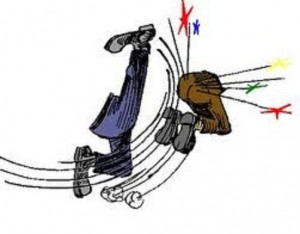Will Calgary will always be a little out of sync with the rest of Canada? Alberta author and Alberta Views humour columnist Fred Stenson tells us why he thinks this.
All posts by admin
Raising the Stakes
In the earlier versions of To Catch a Fox, Julie travelled from Toronto to Vancouver to search for her mother. Now that I had moved from eastern Canada to Calgary, I envisioned her living in my current city. Vancouver, just over the mountains, didn’t feel far enough for her quest.
I was pondering such draft basics after returning from a holiday in Italy. Tuscany would be an appealing setting. Guests at my story retreat would be largely North American transplants, so I could use this exotic location without having to research local culture too much. Except, I couldn’t see Julie hopping on a plane to cross an ocean based on the minimal information she’d have.
My husband Will and I were planning a trip to Los Angeles the next winter. Southern California was the sort of place people went to escape the past and find opportunity. Its meditteranean climate was similar to Italy’s.

In the 1950s, industrialist J. Paul Getty began work on a villa in Pacific Palisades modelled on a country home in ancient Rome. I decided my story retreat could be a similar Italianesque fantasy planted a two or three hour drive south of LA.
On the holiday, Will and I toured prospective locations and chose one near mountains in the orange belt. We also visited the Getty Villa when we stayed in nearby Santa Monica. The apartment we rented inspired another setting in the book.


Previously, Julie had travelled alone on her journey. This time, she’d have a side-kick, a stepsister Delilah with whom she has a prickly relationship. In the old versions, Julie’s father and stepmother had only appeared in flashbacks. Now they would be in the main storyline.
During the novel’s eight or so years in the drawer, Julie had aged six years, from 32 two to 38. Her maturity gained her a husband, Eric, a dentist/poet. They had separated about ten months before the story start due to Julie’s psychological problems. In versions one and two, she’d suffered from depression. I now thought this might be too ordinary. Psychotic would add interest.
From my work in genre fiction, I’d learned about the need to raise the stakes and challenge your protagonist to the core. Mentors advised, make things as bad as you can for her, then make it worse. Since Julie’s main issues related to her mother, I gave her a child she had trouble mothering. Psychosis … troubled mother … Women who kill their children.
Their actions so rare and beyond the pale always shocked me and everyone else. It was unfathomable, intriguing. As I mulled this, I could see how Julie attempting to drown her child would work in the novel. I’d find it hard, if not impossible, to create sympathy for her character, but the idea was there and it would be cowardly to scrap it for that reason.
Multiple viewpoints would help. If readers hated Julie, they might stay the course with one of the other viewpoint characters, whose reliablity would balance Julie’s sometimes skewed observations. My villains would be narrators too, so readers would know what they were up to and worry about Julie. I hoped.
Before starting to write, I also contemplated the novel’s structure. Around the 1/4 point, Julie and Delilah would board a plane for California. Around story mid-point, they’d arrive at the Italianesque retreat. How they got there and what happened along the way would come out in the writing of the story.
Next week, the twelfth and final installment of my writing journey: How to Write a Novel in Your Spare Time.
Numbers
Whenever I drive to Westhills Shopping Centre, I’m always intrigued by the numbers on Signal Hill. So was Calgary native and author Ellen Kelly for personal reasons that she spent a lifetime figuring out.
Mystery, Suspense & Surprise
While waiting to hear from publishers about my first mystery novel Deadly Fall, I wrote a sequel, Secret Spring. After the second draft, I sent it to the Alberta Writers Guild for a manuscript evaluation. The anonymous evaluator said what intrigued him or her most about the book wasn’t the mystery and its assorted twists; it was the relationship between my protagonist Paula and Adriana, a main story antagonist. The evaluator suggested I focus on that and forget about the pure mystery aspects.
I didn’t do this because I was setting up a mystery series, but the prospect of writing a novel that was more suspense-oriented appealed to me. It also got me thinking about the difference between traditional mystery and suspense/thriller novels.
In a mystery, what drives the story is the question ‘whodunit?’. Mysteries are told by a single narrator, the sleuth. The reader learns the answer and experiences other twists along with the protagonist. Since sleuths are usually bright, she or he might be a step ahead of the reader. Genius detectives, like Sherlock Holmes, might be light-years ahead. This makes the mystery genre great at surprising the reader all the way to the big reveal at the end.
Suspense or thriller novels are typically written in multiple points of view that give the reader information the protagonist doesn’t know. Interest is sustained by the questions: will the protagonist figure it out, how will she react when she does, will the bad guy achieve his evil objectives and will the protagonist and other innocent characters die or survive?
While I enjoyed writing murder mystery, part of me longed to try the other approach. Then, to my surprise, I had the idea for a third version of To Catch a Fox, my old novel in the drawer, using the techniques of suspense. I can only suppose that, unknown to my conscious mind, my subconsious hadn’t given up on that novel and was churning away, trying to figure out how to write the story and grabbing bits about mystery and suspense I was writing and learning about.
What my subconscious came up with was this: keep the title, the basic character of Julie Fox, my protagonist with psychological problems, and the jumping off point of her going on a quest to find her mother. Almost everything else about the story would change.
In this reboot, Julie would encounter an antagonist with qualities like Adriana of Secret Spring. The reader gets this bad gal’s perspective and comes to realize that her goal would destroy Julie psychologically. Julie is in the dark about this. I’d also have a bad guy, the Adriana-type character’s unscrupulous colleague who seduces Julie. Will these villains succeed? Will Julie realize in time what’s going on, battle the evil ones and emerge emotionally and mentally stronger? Or will they push her deep into mental illness, with its risk of suicide?
With no publisher yet for Deadly Fall, I finished my revisions on the mystery sequel but didn’t want to start a third book in a series that might never get off the ground. This gave me time to work on the new To Catch a Fox. I would begin the the story from scratch and didn’t even consider looking back at the old manuscript. 
But first, I had to decide on a few basic details, like the setting, the supporting cast and Julie’s particular psychological problems.
NaNo – Day 2
A Night in the Calgary Zoo
Shaun Hunter’s post this week Calgary Through the Eyes of Writers features local author Betty Jane Hegerat’s novel Running Toward Home, about a foster child who finds himself trapped overnight at the Calgary Zoo. I don’t know if Shaun planned this post for Hallowe’en weekend, but a night alone in the zoo would be scary – or exciting! This is a Calgary novel I’ve read. Hegerat juggles five point of view narrators, who are all sympathetic, real and memorable.
Blog Tour
My friend, Glenna Jenkins, is on a whirlwind virtual blog tour. Check out her site for many posts of interest to writers and readers. I’ve read Glenna’s book, Somewhere I Belong, and found it a well-written historical young adult novel with appeal to adult readers, especially for those like me with connections to The Maritimes. Somewhere I Belong is well-deserving of the praise it’s been receiving.
NaNoWriMo
For the first time, I’ve committed to National Novel Writing Month. I won’t be there for the Midnight Kickoff on Hallowe’en night, but the morning of Nov 1st I’ll begin my goal of writing 50,000 words during the month of November. I have been interested in NaNoWriMo for years, have encouraged others to look into it and the stars have finally aligned for my participation. November 1 was when I’d planned to plunge into my post-holiday writing and I feel a need for an outside boost. 
Meanwhile, I’m wrapping up some pre-NaNo projects, including my blog series about my writing journey. The posts will continue to run weekly on this site until November 17th. Check out today’s entry about my second stab at murder.
A Second Stab at Murder
In the early 2000s, some Calgary writers founded Mystery Writers INK, a writing group devoted to sharing technical information and skills for writing mystery stories. In 2003, as my short story binge drew to a close, I decided it was time for another stab at writing a murder mystery novel.
Over the years, I’d been mulling mystery novel premises and now settled on this: my protagonist would be Paula, a woman my age, with a similar background and living in Calgary’s Inglewood neighbourhood, where I’d spent many hours the past two years while serving as Alexandra Writers Centre Society president. Paula’s best friend from childhood is murdered near Paula’s home. Paula comes to suspect the killer is someone close to her friend.
That fall, I joined INK and wrote the story, using a method of continually throwing problems at Paula and raising questions that I’d need to resolve in future chapters. The resulting first draft was reasonably satisfying, if messy and pitted with plot holes.
 The speaker at my first INK session was an expert on guns. This was perfect for me, since a gun was my novel murder weapon. After the session, I pestered him about gun details specific to my story. He offered suggestions for relating different gun types and brands to my characters. The light in his eyes when he talked about guns inspired me to make a key character a gun nut.
The speaker at my first INK session was an expert on guns. This was perfect for me, since a gun was my novel murder weapon. After the session, I pestered him about gun details specific to my story. He offered suggestions for relating different gun types and brands to my characters. The light in his eyes when he talked about guns inspired me to make a key character a gun nut.
Later speakers included experts on poisons, fraud and art theft. My favourites were the police men and women who provided tips on how to get the police details right.
I revised my novel through three drafts, with help from several writing courses and a private critique group I’d formed with two friends from the Alexandra Writers Centre. I was about to start querying agents and publishers, when an INK session on story structure made me see that my novel’s structure was a little off. This prompted me to take an online mentorship through UBC’s Booming Ground program, which led to a year of challenging revision. At the end, I had a fourth draft that was almost ready. One last polish, and I sent out my first queries.
From the start, the response was better than it had been with my first book. After about 30 submissions and a few manuscript requests from agents and publishers, TouchWood Editions made an offer to publish Deadly Fall.
I was thrilled. It had me taken 20 years, with a considerable amount of rejection and hard work, but I’d finally achieved a major writing goal: my first published novel. 
Handling defeat in politics
Here’s a timely post about a Canadian election that happened almost one hundred years ago. I hope that Stephen Harper is finding such peace in his recent political defeat.
